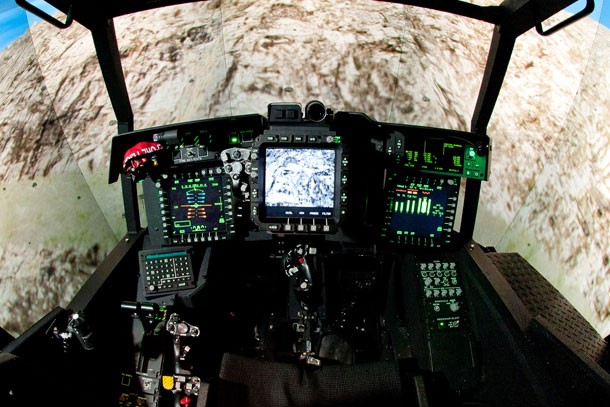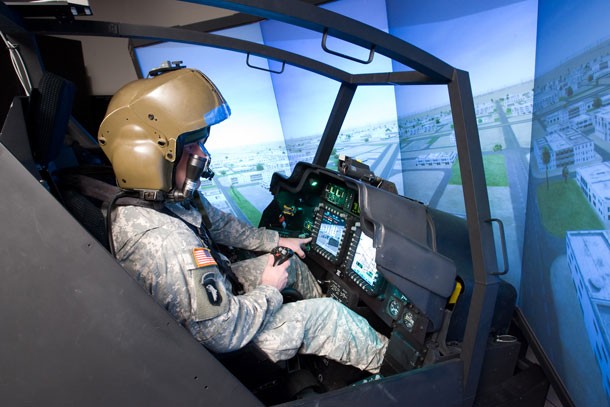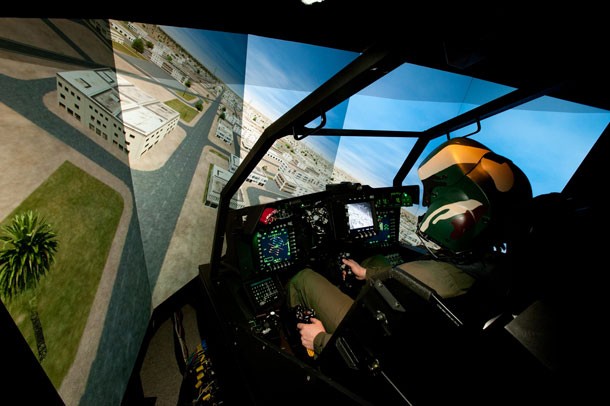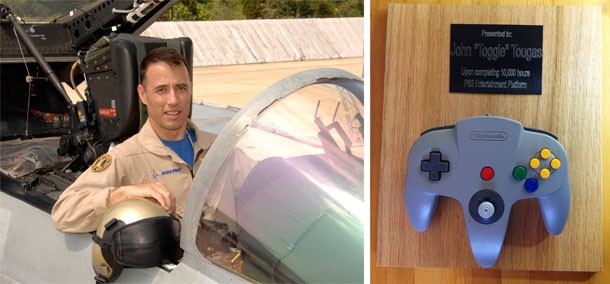Please support Game Informer. Print magazine subscriptions are less than $2 per issue
Taking To The Sky From A Grounded Position: Flight Simulation And Video Games

The military and video game technology have a long history together. The world’s first video games were a product of motivated engineers playing with computer technology that only the military could afford. Without military-funded research into computers, there is a good chance the world’s first video game, William Higinbotham’s Tennis for Two, would have never been born. In the best case scenario, it would have been born much later.
These days, that relationship has changed. The military is now looking towards the video game industry to help create the simulators that give pilots an educational edge before taking planes to the skies. Ryan Kawicki is a software engineer for Boeing helping to create these simulators, but in a previous life he worked in the video game industry. Kawicki was employed by Electronic Arts working on the NCAA and Madden series in 2008 and 2009. Both the commercial video game and simulator worlds have the ultimate goal of creating an interactive piece of digital media for users to explore, but the pathway to the end goal is much different.

Working with Electronic Arts, Kawicki worked on a rigid schedule due to the nature of annualized releases. Releasing a new Madden or a new NCAA game every year offers developers a window of approximately nine to ten months to add new features and update the game. “It was a lot harder working on Madden and NCAA where they were really – I’m not trying to knock them – but it’s really hard for them to take their technology forward, because they are always having to think about the here and now.”
Working on government contracts outside of the commercial world means there is an emphasis on getting it right, rather than getting it released. It’s not the user-focused entertainment media of the commercial world. It is a realistic simulation project built for the defense industry. Kawicki says, "There have been studies that have proven that the more realistic you go, the less enjoyable the experience will be.” In this case, that’s okay. Boeing isn’t out to make something entertaining. It’s trying to make something that realistically emulates the act of flying a plane.
David Lin is a software engineer for Phantom Works, Boeing’s research and development division. He doesn’t have a history with video game development, but he does have a history with video games. He has been enjoying interactive experiences since the Commodore 64, and keeps up with modern gaming as he helps to design Boeing’s top-of-the-line flight simulators. Lin and Phantom Works use X-Plane, a highly realistic flight simulation software program that is commercially available to the public. Lin modifies X-Plane to suit the needs of the simulators. Using X-Plane solves a problem that has existed since flight simulators were first created. Lin says, “The historical objective has been to be true to the actual physics [of flight].” The visual aspects have been important, but secondary.

While Lin’s main concern is making sure the simulated plane feels real from a physics and control perspective, video game technology has solved the problem of visual immersion. Graphics have gotten to a point where simulators can start paying attention to the details, creating believable vistas to further convince the pilots that what they’re looking at is close to what they will actually see when they jump into a real cockpit.
Technically, the pilots are sitting in a real cockpit. The simulators are created from decommissioned planes. The cockpits are removed, surrounded by screens, and in some cases, placed on hydraulics to get as close as possible to how it will feel to be in the air. Pilots spend between 250 and 300 hours in these simulators before they ever take off in a real plane. It’s used as a training method, but even practiced pilots use these simulator/video game hybrids.
John Tougas has been with Boeing for four years, and he refuses to respond to any name other than his call-sign: “Toonces.” He’s an experimental test pilot for Boeing, but he spent 20 years prior in the Navy as an operational fighter pilot. “There are probably only five of me on Earth,” Toonces says. To be piloting in the Navy for so many consecutive years is atypical. The only type of ship that flies through the air that he hasn’t had the opportunity to pilot is a blimp. Along with helping to train new pilots, Toonces helps Boeing craft its simulators, and he also uses them to rehearse for air shows and missions.

John "Toonces" Tougas shows off his award for completing 10,000 hours of PlayStation 2 time, hand crafted by his peers. This was before he adopted the "Toonces" callsign.
Toonces is a lifelong gamer, and acknowledges that the hobby may have contributed to his success as a pilot. As a young pilot, he set records on mock bombing runs. Without the assistance of a computer, Toonces had to learn to drop bombs on giant targets using iron sights, his plane’s altitude, and a book of mathematical equations. The average score for hitting within range of the target was within around 200 feet, but Toonces’ scores were closer to 115 feet. When his supervisors asked how he was so successful with his bomb runs, he pointed towards a golf game he had been obsessing over. Toonces said that later that night, both students and teachers were lined up outside of his room to help their own hand-eye coordination with the help of virtual golf. Toonces still plays games today, marveling at the recent Call of Duty titles that he plays with his sons. When he participates in mock-plane exercises with other countries, he claims to dominate, saying, “I’m not saying it’s because of video games, but there are skills that are transferable. If you’re a fighter pilot trying to make quick decisions in a dynamic environment, and accurately achieve some kind of firing or weapon solution, or some other type, there are skills that can transfer from the video game into the cockpit.”
With all of this technology at their fingertips, the logical question is how they are manipulating the software for their own entertainment purposes, much like the creators of Tennis for Two. “Unfortunately, the environment we develop for is at least existing on a secret level,” said Lin with a laugh, “the applications and games that we can bring in are severely limited.”
Be sure to check out the photo gallery below for more shots of Boeing's flight simulators.



























